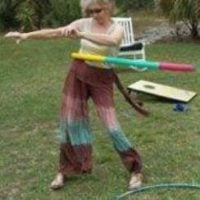Read part one of this series here: Setting Routines to Calm the Mind’s Chaos: an Ayurvedic Perspective.
Read part two of this series here: Setting Routines with Food: an Ayurvedic Perspective.
Read part three of this series here: Setting Routines for Lifestyle: an Ayurvedic Perspective.
Dinacharya translates to daily routine and there are practices that support either morning or evening, although there is some crossover.
Awakening in the early morning is a good time to get the early sun in your eyes to reset your circadian rhythm. If going outside immediately is not feasible, do so a bit later but before the midday sun.
Spritzing the open eyes with fresh cool water, rosewater, or laying a cool compress over the eyes is also good to assist the sense of sight. I also like to do my eye exercises to strengthen their muscles, and it is my first piece of my morning yoga practice.
Tongue scraping removes the buildup of ama, a toxic source of undigested food. Copper or stainless steel scrapers are available for sale, but a spoon held upside down can be used. Investing in a tongue scraper (or more if you travel) is a low-cost investment and necessary for good oral hygiene.
When brushing the teeth, take caution to purchase toothpaste with clean ingredients, and use an earth-friendly toothbrush that can be changed out monthly. Bamboo toothbrushes are a good source, and there are plenty of eco-friendly toothpastes or powders available for sale.
Neem in powdered form combined with virgin coconut oil makes a great toothpaste. Keep it in a small glass container in the fridge to keep it solidified, and remove about an hour before use. Make a small batch since it does not have any preservatives. The bitter flavor helps the digestive fire. Oil swishing the mouth is a personal choice. That takes care of your sense of taste.
If using a spoon, please keep it in the bathroom, just saying. Insert wink here.
Neti pot and or nasya oil are for nasal hygiene and care for the sense of smell. There are contraindications for neti pot use such as a deviated septum, and active sinus infection. The neti pot should be used first and followed by the nasya oil after about 15 minutes to be certain all the salted water has cleared the nostrils. You can also wait until the afternoon to apply the oil. The neti pot needs a small amount of salt; there are prepackaged ones available, or use a Himalayan pink salt, or mineral salt.
Warm filtered water is added to the pot. Over the bathroom sink, hold the pot in one hand and tilt the head to the side and angled. Place the nozzle tip at the opening of the top nostril and gently pour about half the saline solution, lift the head and gently blow the nose, and then repeat on the other side. The oil is either placed 1 or 2 drops to a head tilted back. Lightly pinch the nostrils and sniff to allow the oil to go up through the sinus passages. Keep a tissue on hand in case some oil drips out later.
Ear care for the sense of hearing includes a light massage with oil around the outside of the ears and a small amount of oil on a fingertip, rubbed into a fingertip of the opposite hand to provide a touch of oil in the inside. Also, keeping the volume lower on music, movies, televisions, video games and wear protection if using lawn care tools, or mow by hand powered equipment and let the grass clippings stay on the ground.
The sense of touch can be accomplished through dry brushing (garshana) and warm oil self-massage (abhyanga). These can be done morning or evening and is a personal preference. Dry brushing exfoliates the skin and is not suitable for everyone. It typically is done once a week on the extremities and back. There are long handled ones for reaching the back, mitten style and raw silk gloves. All strokes are gentle and toward the heart. Dry brushing is done prior to oil treatments.
For cold weather, or if cold, use a warming oil of sesame; for hot weather, or if running hot, use a cool oil such as coconut oil. There are also medicated oils to add various herbs such as gotu kola (brahmi). Place a small amount in a small bowl that can be placed in heated water and use the fingers of one hand to dip in and apply the oil. If doing the scalp, hair, and face, start there.
On the face, use gentle strokes to move from the center to the outer and down. Gentle movements will move the lymph. On the arms, hands, feet, and legs, work up toward the heart with long strokes except on joints where you use circular moves. Allow the oil to sit on the skin for a bit and then shower or bathe in warm water. Allow the towel to air dry thoroughly and then wash it.
Do not place oiled towels directly to a clothes dryer since it is a potential fire hazard. If possible, dedicate a towel for massage only, let it air dry and replace it. Or if feasible, air dry, wash, and hang it outside to dry.
I started adding new moon and full moon castor oils packs to my routines and am enjoying it. I pour castor oil on a cloth, cover it with parchment paper and lay it on my pelvis and liver area. Then I add a hot water bottle on top—mine is purple. A hand towel over the hot water bottle completes the preparation as I lie on a beach towel on my bathroom floor. I have not yet made it 45 minutes, but after removing everything except the oil, I put on my jammies and take the hot water bottle and hand towel into the living area and continue the heat therapy for an hour or more.
PS. Do not use expensive towels nor pajamas and toss the cloth after every second or third use. I cut up clean old T-shirts for the oil.
Time now to practice meditation, yoga, and or some movement practice. Get outside in nature and have breakfast no later than 8 a.m. Do not force food if not hungry, but the digestive fire (agni) needs to be kept in healthy condition so it doesn’t become extinguished. Drink hot or warm beverages. Water with or without lemon or lime is a good choice, then herbal teas. Avoid caffeinated drinks and ice and cold beverages.
Enjoy the day and follow the Ayurvedic clock of doshic times of day to eat, work, rest, create, and exercise. Vata is 2 a.m. to 6 a.m., and 2 p.m. to 6 p.m., Pitta is 10 a.m. to 2 p.m. and 10 p.m. to 2 a.m. and kapha is 6 a.m. to 10 a.m. and 6 p.m. to 10 p.m.
The early morning is vata from two to six; sleep is lighter and dreamy. Arising before six is a good time to start the dinacharya of the senses, meditate, chant, and do breath work and a yoga practice.
The morning kapha time is a good time to get the body stronger and do exercise but appropriate for your predominant dosha. It is also a time to get breakfast finished by eight. The outside work of gardening, and lawn care can be done before the sun rises to overhead.
Mid-morning, ten to midafternoon two, is pitta time and the best time to eat the largest meal of the day, a balanced meal of 60 percent nourishing and building foods and 40 percent reducing and lightening foods. Followed by a 10-minute side lying to aid digestion and then a short walk preferably outside.
Vata time is now 2-6 p.m. and time to do those creative activities such as writing, drawing, and playing music. However, take time closer to the end of afternoon to calm down vata with warm or hot chamomile tea and perhaps restorative yoga or nidra yoga.
The evening routines of kapha are designed to continue the care of your physical, mental, and emotional health, as well as your five senses and spirit. The evening is time to slow down activity, preparing the body and mind for a good night’s rest, repair, rejuvenate, and recovery period.
Dinner, lighter than the midday meal, should be completed no later than 7 p.m. if in bed by 10 p.m. and earlier if going to bed around 9 p.m. A warm beverage of milk and turmeric can be consumed closer to bed if extra nourishment is needed.
Wash your face thoroughly; showering or bathing is dependent on the preferred schedule of morning, evening, or both. Do brush your teeth, check your tongue to see if it needs a scraping, oil swish morning and/or evening.
Evening may be your preferred time to do an oil self-massage. The sense of touch can be accomplished through dry brushing (garshana) and warm oil self-massage (abhyanga).
Start at six in the evening to allow electronics to start shutting down and don’t use screens two hours prior to bed. If possible, turn off all LED and fluorescent lighting in the evening and use low watt incandescent bulbs. Switch reading to print materials and calming matter. Violent content and loud noises negatively affect the nervous system, add chaos to the mind, and disrupt the sleep and dreams.
Sleep in a cool, quiet, and dark room with no electronics nor digital displays.
Pitta evening period is from 10 p.m. to 2 a.m. and it’s deep sleep time. At two, vata time arrives until six in the morning and sleep may be lighter and filled with dreams. If you find yourself waking up to use the bathroom, start looking at how much you are hydrating in the evening and adjust to cut off drinking too close to bed.
Arising before six in morning starts your morning dinacharya.
Have fun with this and start small since trying everything at once may lead to quitting altogether.
Ayurveda in your life can bring about incredible changes in your physical, mental, emotional, and spiritual health.
Read part one of this series here: Setting Routines to Calm the Mind’s Chaos: an Ayurvedic Perspective.
Read part two of this series here: Setting Routines with Food: an Ayurvedic Perspective.
Read part three of this series here: Setting Routines for Lifestyle: an Ayurvedic Perspective.
~
Please consider Boosting our authors’ articles in their first week to help them win Elephant’s Ecosystem so they can get paid and write more.












Read 17 comments and reply